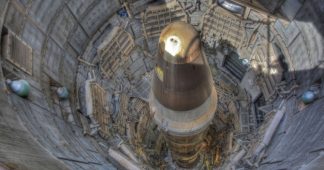The Six Nation Peace Initiative was a joint initiative in 1984 by six heads of government to help end the Cold War and the nuclear arms race between the United States and the Soviet Union. It continued until 1989, and was also sometimes referred to as the Five Continent Peace Initiative. The original six leaders were: President Raúl Alfonsin of Argentina, Prime Minister Indira Gandhi of India, President Miguel de la Madrid of Mexico, President Julius Nyerere of Tanzania, Prime Minister Olof Palme of Sweden and Prime Minister Andreas Papandreou of Greece. During the following five years, Indira Gandhi was replaced upon her death by Prime Minister Rajiv Gandhi of India, and Olof Palme by Prime Minister Ingvar Carlsson of Sweden. The Six Nation Peace Initiative was convened by the New York-based parliamentary network Parliamentarians for Global Action (PGA). The principal convenors were: US Congressman Tom Downey; Nicholas Dunlop, Secretary-General of PGA; Olafur Ragnar Grimsson MA, Member of the Icelandic Parliament who later became President of Iceland; and Senator Silvia Hernández of Mexico.
The Initiative began with a joint declaration issued simultaneously by the six national leaders in their capitals on 22 May, 1984. It began by saying, “Today, the survival of the human race is in great danger. The escalating arms race, growing international tensions and the absence of a constructive dialogue have increased the risk of a nuclear war: a war which would spread death and destruction over the entire world.” As a first step towards “full and general disarmament, accompanied by measures to reinforce the United Nations system,” the heads of government called for an immediate halt to the testing, production and deployment of all nuclear weapons. Having been visited earlier by a PGA delegation to brief him on the Initiative, Pope John Paul II issued a public statement of support on the day it was announced.
The Six Nation Peace Initiative held summit meetings in New Delhi, India (1985), Athens, Greece (1985), Ixtapa, Mexico (1986), and Stockholm, Sweden (1987). The New Delhi meeting was reported on the front page of the New York Times and the Initiative received extensive media coverage around the world. At each meeting, a joint statement was issued. Between these summit meetings, members of the group conducted discussions with the leaders of the United States (President Ronald Reagan) and the Soviet Union (President Mikhail Gorbachev) during bilateral visits, and addressed several joint letters to them. The letters were drafted and meetings organised by a Planning Group made up of senior foreign policy advisors to each leader and representatives of Parliamentarians for Global Action.
President Mikhail Gorbachev of the Soviet Union began a unilateral moratorium on nuclear testing on August 6, 1985, and called on the United States to match it. The Reagan White House declined to do so. On October 30, 1985, the “Six” wrote to the US and Soviet leaders urging a 12-month suspension of nuclear weapons tests by both sides, and offering their help with independent verification. On November 8, 1985, in a reply to the Six which was published in the Communist Party newspaper Pravda, President Gorbachev expressed his readiness to accept the 12-month extension proposed by the group if the United States did likewise. He also expressed interest in their offer of verification assistance. In what was seen as a key move in ending the nuclear arms race, Gorbachev subsequently extended his moratorium unilaterally.
Parliamentarians for Global Action conducted a process of “parliamentary diplomacy” in parallel to the work of the six leaders. At one meeting PGA held with President Gorbachev’s science advisor Yevgeny Velikhov, the PGA delegation asked if the Soviet Union would consider independent verification of its test site by non-governmental scientists. Dr. Velikhov answered that “they would welcome, and they should bring their suitcases for a long stay.” This led to an agreement on May 28, 1986, between the Soviet Academy of Sciences and the New York-based Natural Resources Defense Council (NRDC) that NRDC scientists could establish monitoring stations at the Soviet nuclear test site to reassure the world that nuclear weapons testing there had indeed stopped. PGA also acted as the conduit for a highly unusual communication channel between the Supreme Soviet, the parliament of the USSR, and the US Congress, where there was growing support for a funding cut-off for US nuclear weapons testing in order to match the Soviet moratorium. This included at one point transmitting a formal message from the Supreme Soviet to the US Congress on the nuclear testing issue.
On December 14, 1985, the Six Nation Peace Initiative received the Beyond War Award from the Silicon Valley-based citizen group Beyond War. The award ceremony was conducted in the world’s first satellite link-up of five continents, which was anchored in San Francisco. In 1986 Parliamentarians for Global Action was awarded the first Indira Gandhi Peace Prize (also known as the Indira Gandhi Prize for Peace, Disarmament and Development), which is awarded annually by an international jury and presented by the President of India. Mikhail Gorbachev received the second Indira Gandhi Prize in 1987.











